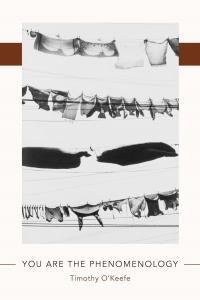Book Review
As Richard Wilbur’s oft-misquoted maxim goes, “Limitation makes for power: the strength of the genie comes of his being confined in a bottle.” In the precision and beauty of its varied form, Timothy O’Keefe’s You Are the Phenomenology is, among other things, a triumph of confinement.
Across the verse and prose of this collection, the poet builds each piece as a carpenter might a house, a room, a wooden box: plane perpendicular to plane, corner interlinking corner, one dimension advancing headlong into the next. In this, O’Keefe’s project is one of design, of methodology. As he offers in “Song of the Seagull Empiricist”:
To externalize
one’s thought,
as buildings
compose the morning
building
joist, cornice, arcade.
The created object, in turn, creates—its boundaries, its surroundings, itself in the mind of the creator. Likewise, O’Keefe’s poems “externalize” those features of consciousness that the poet seeks to pin down. Just as “buildings / compose the morning,” O’Keefe’s pieces act as catalysts for metacognition, points around which the reader’s mind coheres and comes into view.
The poet’s success in building those points of coherence is owed to the choice tools that he undertakes. Like the “Broken Sonnet” of his first collection, The Goodbye Town (2010 Field Poetry Prize winner), the forms utilized in O’Keefe’s latest work are wholly of his own making. Across the text, the reader is treated to varied “Songs,” to an exegetic prose piece, and most commonly to the “Quadrilateral.” Sudden in its transitions, shaking in the precise lyric and image of its individual lines, this is at once the book’s most enigmatic and rewarding form as evidenced by “Quadrilateral: Soluble”:
Where recollection fails, the body takes a fuller stride :
Like books you keep for the marginalia. A dead friend’s boots :
I can listen to the icicles melt and almost no one says much :
We’re each given a palm’s width of ocean. All the way down.
Here, the geometry of O’Keefe’s poetry is apparent. Contrary and coterminous meanings tug at one another like figures on a mobile: weight and counterweight, dependent yet distinct. In the delicate constellation of the poem, one image’s momentum carries to the next: “fuller stride” ripples into “a dead friend’s boots,” which is itself deepened and transformed by the eerie wit of “almost no one says much.” Always the reader’s attention is kept on the space between lines, images, voice, and as O’Keefe puts it, on “Not events, but atmospheres. Not trains in the night, but whistling.”
By attending to this absence, every connection and contradiction provides a surface on which the reader’s mind may be projected. Even the poem’s title, “Quadrilateral: Soluble,” suggests a wonderful irreconcilability to the piece at hand, a set of denotations that refuse to order themselves—“soluble” meaning both “able to solve” and “able to be dissolved.” It’s this precision of paradox that acts as an engine for much of O’Keefe’s writing and bespeaks the poem’s playfulness within its fixed form.
With spare diction and such wide paratactic leaps, each element within O’Keefe’s “Quadrilateral” becomes charged with meaning. The poems’ recurrent colons, for example, contain a multitude of possible functions. To this reader, they appear over time not as punctuation, but as punctures—holes where O’Keefe has stitched together the metaphoric distances that yawn across lines. In each poem, the poet tests the boundaries of his own form, the length of these associative threads, and the sturdiness of the mind’s bridge therebetween.
In the text’s centermost section, which shares its name with the book proper, O’Keefe transitions from verse into lyrical prose. Adopting a dynamic second-person narration, the poet writes:
You now feel clear and cleared, and you begin to wonder if there is such a thing as transparency that is pure enough to render one invisible and hypervisible at the same time, a polestar that offers opposite roads out of the wilderness—both begin on mossy escarpments that descend into forest, both wend through shade flowers and waving boughs, both are mottled in the light and dark patches they’ve passed through when they open, at last, as all things must open, on the same native valley. You look up, as if through trees, and find that your interlocutor is staring right at you, unblinking.
Centering on the vital experience of the speaker, O’Keefe uses prose as a tool to better access the phenomenological questions that he circles. Though the language of the title piece waxes, though the speaker is drawn hither and thither by narrative and his reflection thereon, this section is no less precise or incisive than the verse that it complements. Just the opposite, by situating his work in a social setting, “You Are the Phenomenology” offers exactly what the title professes: a common ground on which one’s personal experience is evidence of, product of, and inroad to a commonly held consciousness between writer and audience.
You Are the Phenomenology provides a mirror by which, to borrow from Seamus Heaney, “the mind’s eye could haunt itself.” For all the power of each new structure that O’Keefe undertakes, the book’s lasting influence comes in the accumulation thereof—in their effect en masse. Across the text, the poet builds and rebuilds units of language, inventing the boundaries that he must then exceed. Poem, book, and consciousness all become variants of O’Keefe’s “palm’s width of ocean,” which—as the reader learns to parse and employ his subtle tools—we may follow “all the way down.”
About the Reviewer
Daniel Schonning is an MFA candidate at Colorado State University in Fort Collins, Colorado. He was a finalist for the 2018 Indiana Review Poetry Prize, and his work has appeared previously in Seneca Review.
